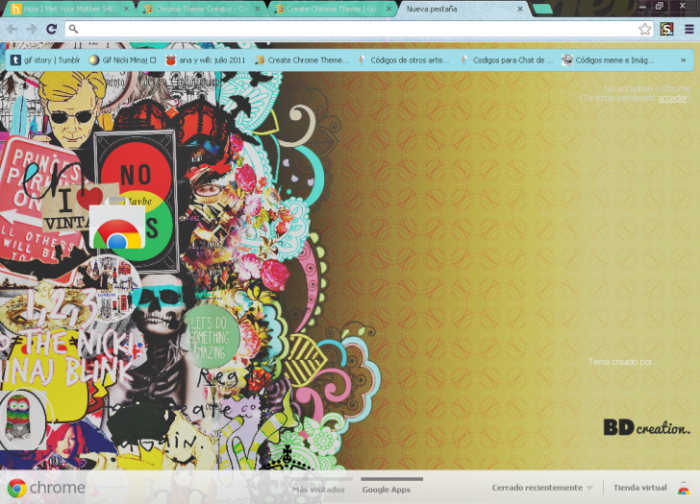Embark on a captivating journey into the world of collage on a theme codehs, where art and technology converge to ignite creativity and innovation. This intriguing art form invites us to explore the depths of computer science through the lens of thematic exploration, offering a unique and engaging way to learn and express oneself.
Delve into the origins and evolution of collage, tracing its rich history from its humble beginnings to its contemporary manifestations. Discover the power of thematic collage in conveying personal narratives, social commentary, and abstract ideas.
Collage Definition and History

Collage is an art form that involves combining various materials, such as paper, fabric, photographs, and other found objects, to create a new work of art.
The origins of collage can be traced back to the early 20th century, when artists such as Pablo Picasso and Georges Braque began experimenting with this technique. However, the term “collage” was not coined until 1912, by the art critic Guillaume Apollinaire.
Evolution of Collage
Since its inception, collage has evolved significantly. In the early 20th century, artists primarily used collage to create abstract works of art. However, in the 1950s and 1960s, artists began to use collage to create more representational works of art, often with political or social messages.
Today, collage is a widely used art form, and artists continue to explore new and innovative ways to use this technique.
Thematic Collage

A thematic collage is a type of collage that focuses on a specific theme or idea. The purpose of a thematic collage is to explore and express that theme through the use of various materials and techniques.
Themes can be explored in collage in a variety of ways. Some common approaches include:
Visual Metaphor
Using images and objects to create a visual representation of a concept or idea. For example, a collage about the theme of “nature” might include images of trees, flowers, and animals.
Narrative
Telling a story or conveying a message through the use of images and objects. For example, a collage about the theme of “immigration” might include images of people leaving their homeland, traveling to a new country, and starting a new life.
Symbolic
Using images and objects to represent abstract ideas or concepts. For example, a collage about the theme of “peace” might include images of doves, olive branches, and rainbows.
Emotional
Expressing emotions or feelings through the use of images and objects. For example, a collage about the theme of “love” might include images of hearts, flowers, and couples holding hands.
Collage on a Theme: Collage On A Theme Codehs
In the realm of computer science education, CodeHS stands out as a pioneering online learning platform. Its innovative approach has made it a preferred destination for students and educators alike, fostering a deep understanding of the subject matter.
Within the CodeHS ecosystem, the concept of a “collage on a theme” takes center stage. This unique approach involves the creation of a digital collage that showcases a student’s understanding of a specific computer science concept. By combining various elements such as code snippets, diagrams, and written explanations, students are able to demonstrate their grasp of the topic in a creative and engaging manner.
Examples of Thematic Collages

CodeHS students have created a variety of thematic collages, showcasing their creativity and understanding of the concept. These collages explore various themes, ranging from personal experiences to social issues, and employ diverse techniques and approaches.
Techniques and Approaches
The collages exhibit a wide range of techniques and approaches, including:
- Digital collage:Using digital tools to combine images, text, and other elements.
- Physical collage:Creating collages using physical materials such as paper, fabric, and paint.
- Mixed media collage:Combining both digital and physical elements in a single collage.
- Narrative collage:Telling a story or conveying a message through the arrangement of images and text.
- Abstract collage:Exploring visual elements and textures without a specific narrative or representational goal.
Methods and Procedures

Creating a thematic collage on CodeHS involves a series of steps that guide you through selecting a theme, gathering materials, and composing the collage.
Selecting a Theme, Collage on a theme codehs
The first step is to choose a theme that resonates with you. Consider your interests, passions, or current events that inspire you. A well-defined theme will provide direction and focus for your collage.
Collage on a theme codehs is a great way to explore different topics and learn new things. If you’re interested in learning more about the beak of the finch, you can check out this article: beak of the finch answers . This article provides a comprehensive overview of the topic, including information on the different types of beaks, how they are used, and how they have evolved over time.
After reading this article, you’ll have a better understanding of the beak of the finch and its role in the evolution of the species. So, if you’re interested in learning more about collage on a theme codehs, be sure to check out this article.
Gathering Materials
Once you have a theme, gather materials that represent your chosen topic. This can include images, text, fabric, or any other materials that convey your ideas. Consider using magazines, newspapers, old photographs, or digital resources.
Composing the Collage
Arrange the materials on a digital or physical canvas to create a cohesive and visually appealing composition. Experiment with different layouts, colors, and textures to convey your theme effectively. Consider the overall balance, contrast, and flow of the collage.
Visual Elements and Design Principles
Visual elements and design principles are crucial for creating impactful thematic collages. Color, shape, and texture play a significant role in conveying emotions, creating visual interest, and guiding the viewer’s eye.
Color
- Colors evoke emotions and associations. Warm colors like red and orange convey energy and excitement, while cool colors like blue and green create a sense of calm and tranquility.
- Contrasting colors can create visual tension and draw attention to specific elements. Complementary colors, such as red and green or blue and orange, can enhance the vibrancy of the collage.
- Color harmonies, such as monochromatic (shades of a single color) or analogous (colors adjacent on the color wheel), create a cohesive and pleasing visual experience.
Shape
- Shapes create structure and define the composition of the collage. Geometric shapes, such as squares and circles, convey order and stability, while organic shapes, such as leaves and flowers, add a sense of movement and fluidity.
- Varying the size and scale of shapes can create visual hierarchy and depth. Larger shapes dominate the foreground, while smaller shapes recede into the background.
- Shapes can also be used to create negative space, which can enhance the overall impact of the collage by providing contrast and allowing the viewer’s eye to rest.
Texture
- Texture adds depth and visual interest to the collage. Rough textures, such as sandpaper or burlap, can create a sense of age and authenticity, while smooth textures, such as silk or glass, convey elegance and refinement.
- Combining different textures can create a dynamic and engaging composition. For example, a collage featuring both smooth and rough textures can evoke a sense of contrast and intrigue.
- Texture can also be used to create a sense of depth by layering materials with varying textures.
Design Principles
- Balance: Distribute visual elements evenly throughout the collage to create a sense of equilibrium. Symmetrical balance creates a formal and orderly appearance, while asymmetrical balance creates a more dynamic and visually interesting composition.
- Contrast: Use contrasting elements, such as light and dark colors or large and small shapes, to create visual interest and draw attention to specific elements.
- Emphasis: Highlight a particular element or area of the collage by using focal points, such as a contrasting color or a larger shape, to draw the viewer’s eye.
Meaning and Interpretation

Thematic collages offer a multifaceted canvas for personal expression, social commentary, and abstract exploration. Their unique combination of images, textures, and symbols allows artists to convey complex ideas and narratives.
Personal narratives often emerge through collages as artists weave together fragments of their own experiences, memories, and emotions. By juxtaposing personal photographs, handwritten notes, or found objects, they create a visual tapestry that reflects their inner worlds.
Social Commentary
Collages can also serve as powerful tools for social commentary. Artists may incorporate political imagery, newspaper clippings, or other cultural artifacts to critique social issues, highlight injustices, or provoke reflection on societal norms.
Abstract Ideas
Beyond personal narratives and social commentary, collages can explore abstract ideas and concepts. By manipulating shapes, colors, and textures, artists can create visual representations of emotions, dreams, or philosophical inquiries.
Technology and Collage
The advancement of technology has revolutionized the art of collage, introducing new possibilities and enhancing the creative process. Digital tools have become indispensable for collage artists, offering a vast array of materials, effects, and sharing platforms.
The use of digital collage software allows artists to manipulate images with precision, create seamless compositions, and experiment with various effects and filters. These tools provide access to a vast library of digital images, textures, and backgrounds, expanding the range of materials available for collage.
Advantages of Digital Collage Tools
- Precision and control:Digital tools offer precise control over image manipulation, allowing artists to adjust details, crop, and resize with accuracy.
- Extensive material library:Digital collage software provides access to vast online libraries of images, textures, and backgrounds, expanding the possibilities for composition.
- Experimentation and innovation:Digital tools enable artists to experiment with various effects, filters, and blending modes, fostering innovation and unique visual outcomes.
- Collaboration and sharing:Digital collage platforms facilitate collaboration between artists and allow for easy sharing of artworks on social media and online galleries.
Limitations of Digital Collage Tools
- Loss of tactile experience:Digital collage lacks the tactile experience of working with physical materials, which can be a source of inspiration and creative exploration.
- Dependence on technology:Digital collage relies on software and hardware, which can be subject to technical issues or compatibility problems.
- Potential for digital manipulation:Digital collage tools can be used to manipulate images, raising ethical concerns about authenticity and the integrity of the artwork.
FAQ Guide
What is the purpose of a thematic collage?
Thematic collages provide a unique platform for exploring specific themes or concepts, allowing artists to express their ideas and perspectives through a visual medium.
How can I create a thematic collage on CodeHS?
CodeHS offers a user-friendly platform for creating thematic collages, guiding students through the steps of selecting a theme, gathering materials, and composing their artwork.
What are the benefits of using digital tools for collage?
Digital tools provide a wide range of possibilities for collage creation, allowing artists to experiment with different techniques, manipulate images, and create dynamic compositions.